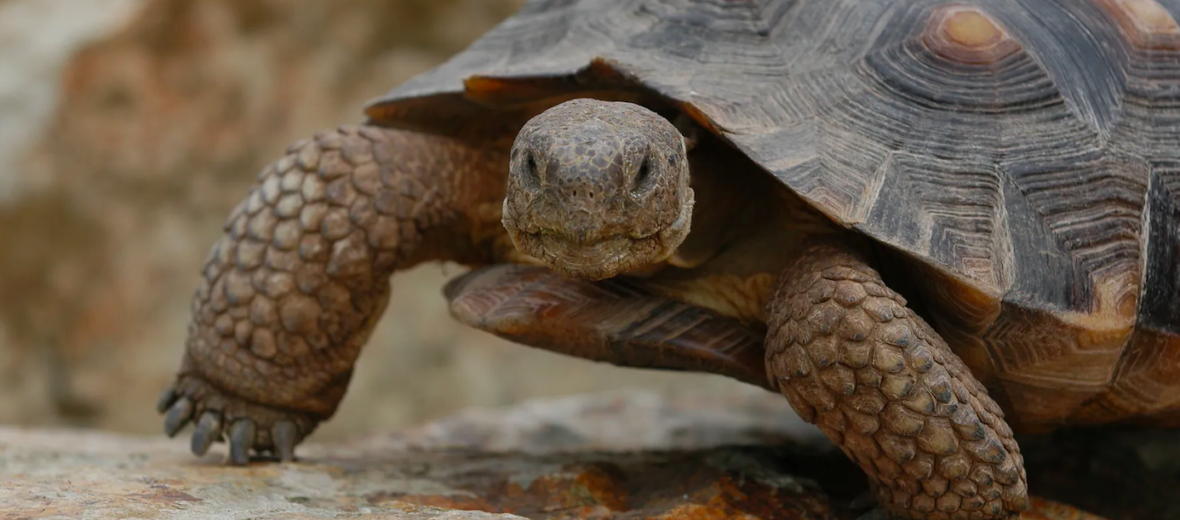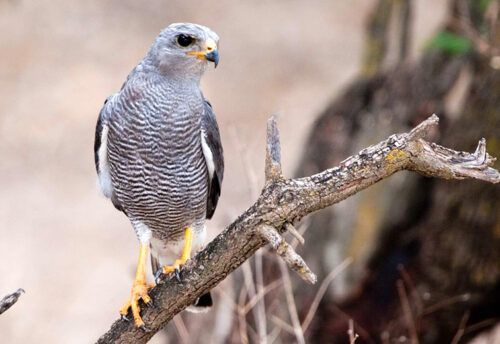
The desert tortoise is adapted to live in extremely hot desert environments. They are found in the Mojave Desert of California, Utah, Nevada, and the Sonoran deserts of Arizona and Mexico. Desert tortoises live in areas that are surrounded by rocky canyons, creosote bushes, semi-arid grasslands, and dry hillsides. These slow critters typically live at altitudes of 1,000 – 3,000 feet, but they have even been found at elevations of up to 5,000 feet. Desert tortoise numbers have dropped over 90% in the past 30 years due to non-native species introduction, habitat loss, disease, and illegal pet trade collections. Desert tortoises from the western part of Mojave Desert are listed as Vulnerable by the IUCN.
First the Stats…
Scientific name: Gopherus agassizii & Gopherus morafkai
Weight: Up to 12 lbs.
Length: Up to 14 inches
Lifespan: Up to 80 years
Now on to the Facts!
1.) Like many other tortoises, these critters are herbivores (eat only plant matter). This diet also helps to disperse seeds from the plants they eat.
2.) This tortoise is a keystone species in that they not only disperse seeds from the plants they eat, spreading plants throughout the deserts, but they also dig burrows that are used as homes by numerous other animals.
3.) During hotter summer periods, the desert tortoise will retreat to their burrows and go into estivation (kind of like resting) to escape the summer heat.
4.) Large, cone-shaped scales on their limbs help them retain water and also protect them from cactus spines.
5.) Their long claws aid in digging burrows that, when abandoned, can fill with water during infrequent rains. The tortoises remember where these “water holes” are located and will return to drink from them after a rainfall.
But wait, there’s more on the desert tortoise!
6.) They can store up to 40% of their water in their bladder. When they urinate, they create a substance called urate. This is a very dry white substance that removes salts and waste from their bodies while reducing the amount of water that is lost. Pretty cool trick!
7.) During the cold winter months, these tortoises will brumate (hibernation for reptiles) in their burrows; filling up the entrance to their burrow with dirt to keep out the cold.
Did you know…?
Desert tortoises are a protected species. If you are caught harassing, touching, or removing one from it’s habitat, you can face a large fine and possible jail time. So leave them alone.
8.) Pack rats, kangaroo rats, burrowing owls, banded geckos, jackrabbits, gopher snakes, rattle snakes, and cactus wrens all use tortoise burrows as a safe haven. Sometimes several animals at once will inhabit the burrows… while the tortoise is using it. Talk about 3’s a crowd!
9.) Burrows are dug at about a 45° angle and go as deep as 3 – 4 feet. Some burrows, dug into dry river banks, have been recorded to be up to 30 feet deep and contain up to 17 tortoises!
10.) Their primary predators are coyotes, kit foxes, skunks, badgers, ravens, ground squirrels, Gila monsters, and roadrunners. These creatures prey on juvenile & adult tortoises as well as on tortoise eggs.
But wait, there’s even more on the desert tortoise!
11.) The desert tortoise can survive up to a full year, or longer, without drinking water!
12.) During mating season (from late summer to early autumn) males will fight for the right to breed with a female. They do this by ramming each other with their gular horn (part of the plastron under their head) and try to flip each other over.
Did you know…?
Tortoises emit several types of sounds, including: grunts, hisses, and moans. The males are very vocal during mating.
13.) Females can store sperm for a very long period of time (delayed implantation) and when they give birth, they lay between 2 – 14 ping pong ball sized eggs in a den next to her burrow. Cooler temperatures typically produce males, while warmer temperatures produce females.
14.) Males have 2 large white areas on their heads called chin glands. These are used to store testosterone.
Now a Short Desert Tortoise Video!
Also, check out the Critter Science YouTube channel. Videos added frequently!
Want to suggest a critter for me to write about? Let me know here.



